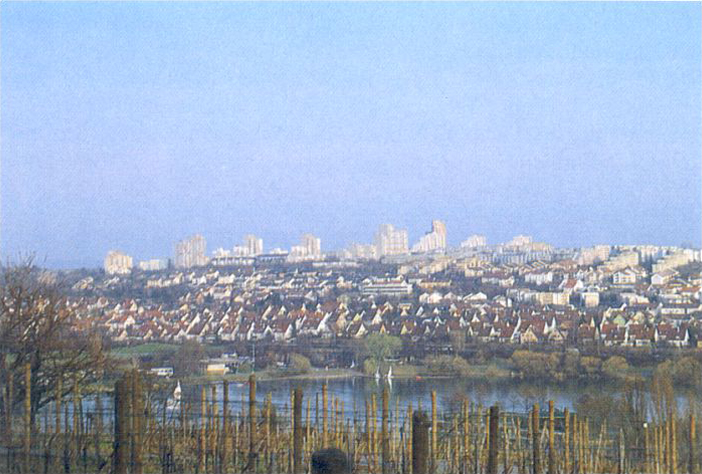|
|
| ENERGY-CONSCIOUS PLANNING AND ZONING |  |
| | | |
 3.4.3 Increase in Wind Velocity with Height 3.4.3 Increase in Wind Velocity with Height |
At increasing heights above the ground the wind-braking effects of obstacles near the ground decrease. As a consequence of decreasing ground friction forces, wind velocity increases with height (see also Figure 2/9).
As such, a higher wind velocity level prevails on mountain peaks, which is also the case for flat, obstruction-free or "cleared" landscapes with their lowered ground friction forces. Areas of development at higher altitudes are thus subject to in large measure to wind effects that consume heat energy. This energy-related disadvantage is increased even more in the case of skyscrapers, since these are continuously exposed to the zone of higher wind velocities. On the basis of the especially unfavorable relationship between the heat-transferring exterior surfaces (A) and the building volume that they enclose (V), a so-called cooling-fin effect is produced (i.e. in the case of a large A/V relationship). It must be taken into consideration that skyscrapers – as salient obstructions to airflow – amplify the turbulence conditions of wind flow, increasing the air exchange and the amount of heat transmission near the ground as well as in the vicinity of the skyscrapers themselves.
Recommendations
With regards to building construction, disadvantageous wind effects can be largely avoided through sufficient heating insulation and dense building joints. In addition, heating energy loss can be prevented by a correspondingly efficient urban development concept.
The necessity of building concepts that take into consideration protection from wind is largely a question of the prevalent wind velocities at a location and is thus far greater along coasts than in landlocked areas. In the case of windy locations on cleared-out landscapes or on hill- and mountaintops, however, the following elements of a wind protection concept should be considered:
Compact building forms that avoid broad surfaces exposed to the main direction of the wind, and that also support the goal of optimal wind protection in the interior areas (i.e. enclosed by buildings) of the development,
- Structural designs for buildings with an A/V relationship as small as possible for the entire development (ideal models: sphere and cube),
- Placing or use of existing wind protection (e.g. evergreen trees) opposite western and eastern walls,
- Avoidance or reduction of tunnel-like gaps and passages.
In probably wind loaded large-scale projects is a study of the development model in the wind tunnel (Chapter. 4.2) or by flow simulation (Chapter. 4.3)makes sense.
|
|
| | | |
 |
| Fig. 3/29: "Cooling fin effect" of a skyscraper development on a hilltop as a negative example |
|
